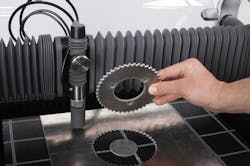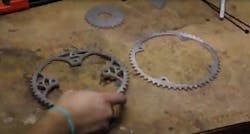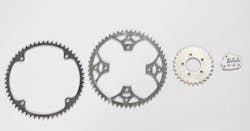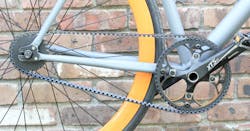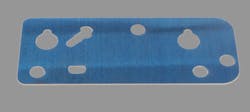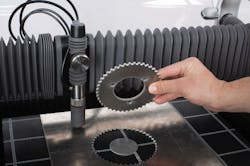Eliminate Outsourcing Pitfalls With Waterjet Cutting Technology
Outsourcing the fabrication of custom sheet metal parts presents a great challenge to engineers and manufacturers who need custom parts on-demand, as outsourcing typically extends the project time by days or even weeks. In addition, it's challenging to quantify hidden costs associated with project delays, and longer wait times can generate surprise expenses and impede operational efficiencies.
The solution for engineers and manufacturers lies in small-format digital cutting tools that are accessible and easy to use, for in-house fabrication instead of outsourcing.
Using high-pressure water mixed with abrasive particles, waterjet cutting machines can cut through virtually any material, including metal, plastic, composites, and rubber. As it's a cold-cutting process, there is no heat distortion or ventilation requirements, producing fewer toxins than other cutting methods. Because of this, waterjets with a smaller footprint are highly practical, cost-effective, and beneficial for building custom parts in-house, keeping projects moving quickly and reducing unnecessary costs.
Prototyping
Iteration cycles (design > build > test > evaluate > repeat) are inherent to the design process. Take, for example, product design engineers at a bicycle manufacturer who need to make a series of prototypes as they develop new designs. Because it can take so long to have custom parts made, the “build” phase of the process can often create a lengthy bottleneck. Affordable subtractive tools allow engineers to make metal prototypes in-house, perform tests and make changes quickly.
Waterjets allow the engineer to prototype using the same material that will be used in the final product for more accurate evaluation. If the engineer is designing a new belt-drive system for a bicycle, for instance, they can make aluminum sprockets so that the prototype is fully functional. Whereas 3D-printed plastic prototypes could test the fit of the parts in the assembly, they would not be suitable for a real-life “road test” because a plastic sprocket could not handle the load of actual riding.
Getting the prototype built could take weeks if the engineer were to get the same custom parts made at an outside fabrication shop. As the job itself is not an enormous undertaking for any fabrication company, it may be a low priority—adding further delay.
If a mistake were made in any part of the build or the parts themselves didn’t work, the entire process would have to be restarted, potentially adding weeks of time to the project. Once the parts are shipped back to an engineer, a fragmented supply chain riddled with disruptions often extends wait times, especially if the parts are made overseas.
Fabricating sheet metal prototypes in-house eliminates the uncertainty and added costs of outsourcing and keeps the project moving forward. By creating parts using the correct materials, engineers can move through iteration cycles more quickly and finalize designs on schedule.
Manufacturing Tooling
In addition to increasing prototyping capability, small-format waterjet cutters can support a manufacturing process by fabricating custom jigs, fixtures, and other tooling to keep the production line moving.
A machine shop that needs custom shims made for tool and die maintenance is another specific scenario that benefits from in-house waterjet cutting. Tool & die makers will often do repairs and maintenance on the dies they make for their customers. After a die wears from repeated use, it is “lifted” to its original height by placing a custom shim made from tool steel underneath. Because this is a very hard material, and tough to cut by hand, manufacturers that lack in-house cutting capabilities often have no choice but to outsource fabrication.
When a manufacturer’s die needs repair, it must be done quickly to eliminate downtime. Outsourcing the cutting of custom shims is not a preferable option as it results in additional downtime. Every day the die sits in the repair shop is a day not in operation making parts.
Instead of using an angle grinder or other handheld power tools (the old-fashioned way), some companies are turning to small format waterjet cutters to cut custom sheet metal parts. These digital cutting machines allow manufacturers to make jigs, fixtures, and other tooling on the same day to reduce production delays. And since waterjets cut designs based on a digital (CAD) file, they allow for exact replication, creating multiple copies if needed.
Innovations in Subtractive Cutting Tools
The personal computer delivered a digital revolution—increasing the productivity of the workforce and the flow of ideas and information, and making computing widely accessible for everyone. Likewise, we are in the midst of a manufacturing revolution whereby new, affordable tools enable designers and engineers to create designs and solve problems more quickly.
Beginning a decade ago with the emergence of low-cost additive technologies like desktop 3D printers, this revolution has grown to encompass a suite of subtractive cutting tools as well, including laser cutters, CNC machines, and waterjet cutters that are now affordable. Just as these compact tools benefit small businesses and entrepreneurs, they are also a lifeline for manufacturers of all sizes to avoid the pitfalls of outsourcing.
Historically, waterjet cutters were not accessible to all companies, as their large size and expense only suited large industrial businesses. WAZER is the first desktop-sized waterjet cutter, bringing industrial-grade waterjet cutting technology to any factory, shop or studio at a market-leading price point. The product’s modern software interface and simple workflow means that anyone with some basic shop experience can install and use the machine, without the need for extensive training.
As industrial manufacturing technologies become increasingly accessible, more creative minds are turning their ideas into physical realities. Who knows what innovations will emerge from this democratization of manufacturing?
Nisan Lerea is the Co-Founder and CEO of WAZER and an inventor of the world’s first desktop waterjet cutter. A consummate “maker,” Nisan spent many hours in the machine shop during his time at the University of Pennsylvania working on projects including a Formula 1-style race car. He needed to cut sheet metal but only had access to laser cutting, which could only cut soft materials. Nisan set out to solve the problem, inventing the first small-scale waterjet that would become WAZER. While working as a mechanical engineer, Nisan realized that other designers and engineers still faced barriers to waterjet cutting, so he teamed up with a former colleague and fellow Penn Engineering student Matt Nowicki to launch WAZER in 2016.
About the Author

Nisan Lerea
CEO, WAZER Inc.
Nisan Lerea is the Co-Founder and CEO of WAZER and an inventor of the world’s first desktop waterjet cutter.
A consummate “maker,” Nisan spent many hours in the machine shop during his time at the University of Pennsylvania working on projects including a Formula 1-style race car. He needed to cut sheet metal but only had access to laser cutting, which could only cut soft materials. Nisan set out to solve the problem, inventing the first small-scale waterjet that would become WAZER.
While working as a mechanical engineer, Nisan realized that other designers and engineers still faced barriers to waterjet cutting, so he teamed up with a former colleague and fellow Penn Engineering student Matt Nowicki to launch WAZER in 2016.
